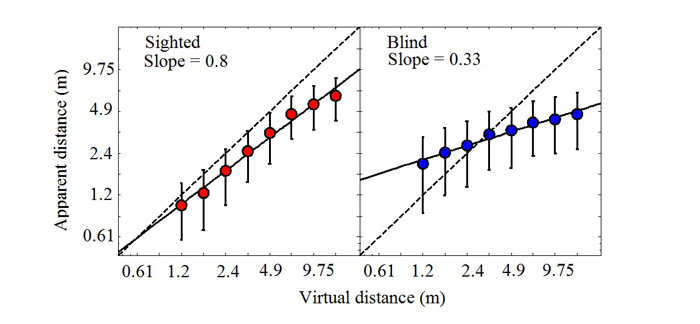The Consequences of Blindness for Judging the Distance of Sound Sources: A “compression” of the auditory world
Andrew Kolarik – ak771@cam.ac.uk
Brian Moore – bcjm@cam.ac.uk
Department of Psychology
Downing Site
Cambridge University
Cambridge, CB2 3EB
United Kingdom
Shahina Pardhan – shahina.pardhan@anglia.ac.uk
Silvia Cirstea – Silvia.Cirstea@anglia.ac.uk
Vision and Eye Research Unit (VERU)
Postgraduate Medical Institute
Anglia Ruskin University
Eastings 204, East Road
Cambridge, CB1 1PT
United Kingdom
Popular version of paper 1pPPb24
Presented Monday afternoon, June 3, 2013
ICA 2013 Montreal
There is currently great interest among researchers regarding whether blindness improves or impairs auditory spatial abilities (Collignon et al., 2009). Many studies have shown that blind listeners often develop superior abilities to use sound to provide information about their surroundings, such as when locating where a sound is coming from (Lessard et al., 1998; Voss et al., 2004), using echolocation to find objects (Schenkman and Nilsson, 2011), or telling which of two sounds is closer (Kolarik et al., 2013). Recent evidence has shown that areas of the brain responsible for processing visual stimuli become responsive to sound following blindness, and this has been suggested to contribute to this high performance (Voss et al., 2010). However, there are some tasks for which blind listeners show worse performance, such as telling where a sound is located vertically (Lewald, 2002). These findings suggest that sometimes vision is needed to calibrate the auditory system, to help provide information about where sounds are located. The ability to tell how far away objects are using sound is of paramount importance to blind listeners in order to avoid collisions with obstacles, such as other people or vehicles. This ability has not yet been assessed, and was the focus of our study.
Sighted participants are fairly accurate at judging the distance of sound sources that are approximately 1 m away, but tend to underestimate distances to farther sound sources (Zahorik et al., 2005). Sound level, a measure of sound magnitude, provides the best information about how far away a sound source is (Mershon and King, 1975). Sound level falls by 6 dB for each doubling of the source distance, so sounds that are farther away have low levels and closer sounds have high levels at the listener’s ears
.
We presented a man speaking a sentence from virtual distances between 1.2 and 13.8 m from each participant, who had to report how far away they thought the sound source was. Six sighted and five blind participants who had lost their sight within five years of birth took part in the study.

Figure 1. Mean distance judgments of sighted (left panel, red circles) and blind (right panel, blue circles) participants. The virtual distance of the sound source is shown on the x axis, and the mean estimate of distance is shown on the y axis. The vertical bars show ± one standard error, a measure of the variability across participants. The dashed lines indicate where the points would fall if judgments were perfectly accurate.
The results are shown in Figure 1. For sighted participants, accuracy was highest for closer sound sources. The distances of remote sources were underestimated by an amount that increased as distance increased. Blind participants overestimated distances for closer sources, and underestimated distances for remote sources to a greater extent than sighted participants. Thus, early-onset blind participants are less accurate than normally sighted participants at judging how far away sounds are. As a result, perceived auditory distance is “compressed” for blind listeners, as indicated by the shallow slope of the solid line in the right panel of Figure 1.

Figure 2. Schematic of the effects of blindness on auditory distance perception. Sighted listeners tend to be more accurate at telling how far away closer sounds are, while underestimating distance to farther sounds. Blind listeners underestimate the distance of farther sounds even more, and overestimate the distance of closer sounds, so that the auditory world shrinks and is “compressed.”
These results suggest that in far space (beyond reaching and grasping distance where information about the distance of a sound source can be provided by touch), the lack of a visual signal causes the brain to produce a less accurate estimate of the distance of a sound source. As a result, while blind listeners have enhanced abilities to judge some aspects of sound source location, for example, locating which direction a sound is coming from, this enhancement occurs only within a compressed representation of the auditory world (see Figure 2). The findings suggest that blind listeners may benefit from orientation and mobility programs designed to help use distance information in sound to improve accuracy, and that built environments for blind listeners should provide as much information about distance as possible, for example including reverberation, which is a powerful cue to distance (Zahorik et al., 2005). The results also suggest that hearing aids designed for blind listeners with hearing loss should aim to maximise information about distance. Hearing aids generally increase the level of weak sounds to help restore speech intelligibility. However, because sound level is used to tell how far away a sound is, any alteration of sound level may distort this cue and make it more difficult for blind listeners to use sound to perceive the distance of objects. This has yet to be assessed.
References
(1) Collignon, O., Voss, P., Lassonde, M., and Lepore, F. (2009). "Cross-modal plasticity for the spatial processing of sounds in visually deprived subjects," Experimental Brain Research 192, 343-358.
(2) Kolarik, A. J., Cirstea, S., and Pardhan, S. (2013). "Evidence for enhanced discrimination of virtual auditory distance among blind listeners using level and direct-to-reverberant cues," Experimental Brain Research 224, 623-633.
(3) Lessard, N., Pare, M., Lepore, F., and Lassonde, M. (1998). "Early-blind human subjects localize sound sources better than sighted subjects," Nature 395, 278-280.
(4) Lewald, J. (2002). "Vertical sound localization in blind humans," Neuropsychologia 40, 1868-1872.
(5) Mershon, D. H., and King, L. E. (1975). "Intensity and reverberation as factors in the auditory perception of egocentric distance," Attention, Perception, & Psychophysics 18, 409-415.
(6) Schenkman, B. N., and Nilsson, M. E. (2011). "Human echolocation: Pitch versus loudness information," Perception 40, 840.
(7) Voss, P., Collignon, O., Lassonde, M., and Lepore, F. (2010). "Adaptation to sensory loss," Wiley Interdisciplinary Reviews: Cognitive Science 1, 308-328.
(8) Voss, P., Lassonde, M., Gougoux, F., Fortin, M., Guillemot, J. P., and Lepore, F. (2004). "Early- and late-onset blind individuals show supra-normal auditory abilities in far-space," Current Biology 14, 1734-1738.
(9) Zahorik, P., Brungart, D. S., and Bronkhorst, A. W. (2005). "Auditory distance perception in humans: A summary of past and present research," Acta Acustica united with Acustica 91, 409-420.

